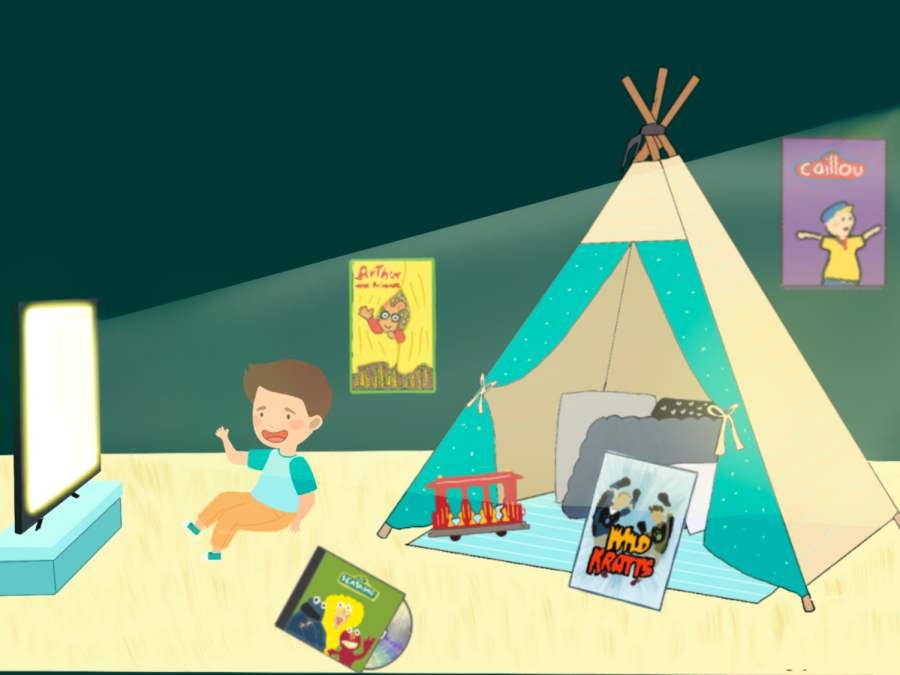Watching the impact of children’s shows
Graphic illustrations by Inaaya Yousef
Despite the seemingly innocuous nature of these children’s shows, studies have shown the large impact they have on children’s development
April 10, 2023
Gathering in front of a screen, ready to watch cartoons has been a staple of American childhood for generations; yet despite the seemingly innocuous nature of these shows, studies have shown the large impact they have on children’s personalities and development, exposing them to new ideas and stereotypes while impacting aggression levels.
Though doctors recommend that children should limit TV time to one to two hours of television per day, most kids spend around three to four hours with the screen. Medical experts believe that babies under two years old should not watch TV at all.
“The length of screen time is correlated with some negative outcomes like increased obesity, higher BMI, and can slow down a child’s development of language,” school psychologist Brittany Stevens said. “This is because so much of the early life brain is wired to get language from watching human faces and their facial expressions and having the interaction in real time and in real life.”
Especially for children under 5 years old, long exposure to TV has been associated with lower cognitive development and limited face-to-face social skills. Those who see violent characters are more likely to imitate that behavior, leading to higher levels of aggression in children.
A study conducted at the University of Michigan found that early exposure to TV violence could predict aggression in adulthood, following gender stereotypes seen on TV. Men were more likely to engage in physical aggression, whereas women were more likely to engage in verbal aggression.
Another study on the relationship between violence on TV and children from the University of Montreal concluded that toddlers exposed to violence on screen are less engaged and motivated in the classroom, getting worse grades even at the age of 12, a decade later. In the experiment, four-year-olds who watched 9 minutes of SpongeBob, which is faster-paced and a comedy show, performed worse on executive function tests taken immediately after, than peers who watched 9 minutes of Caillou, which is slower-paced and focuses more on particular learning objectives.
“There’s a significant correlation of increased aggression and violence in children who view violent cartoons and in general, violent content,” said Stevens.
A lifetime of viewing stereotypical media becomes ingrained in a child’s brain, ultimately affecting their future relationships, career choices, and self-worth. For example, media that reinforces the idea that masculine traits and behaviors are more valued than feminine traits and behaviors leads boys who consume these media messages to become more likely to exhibit stereotyped masculine behaviors and beliefs.
But not all children’s TV shows are harmful, with educational content allowing kids to learn about new academic topics and cultures. Shows such as “Sesame Street” that focus on everything from the alphabet to how to follow one’s moral compass provide ways for children to learn while being entertained.
“These shows are kids’ version of pop culture because it gives them something to talk about,” senior Serena Kher said. “TV shows can also be really educational and expose children to what they’re interested in.”
Since children often do not get a very vivid learning experience from the 2D screen, interactive shows like “Dora the Explorer” add audience engagement portions, which encourage conversational skills within young viewers. TV can also introduce children to a diverse array of cultures and show them places they can’t see in person. Furthermore, younger children tend to model the behaviors they see around them; positive role models on TV shows can help children form good character traits, while the opposite is true if they see negative role models on TV.
“TV can help a child learn a lot of new things, especially TV shows from different parts of the world,” Kher said. “I see a lot more TV shows doing their best to include people from different backgrounds. It opens children’s minds up to a lot more topics that they might not be exposed to in their household.”
A study at Texas Tech University found that many children displayed positive traits when watching TV with their parents. By pointing out connections or asking children to make their own while watching, parents can help their development by showing them how TV content is relevant to real life.
“It’s important to have variety, moderation, and thoughtful consumption,” Stevens said. “Watch something that is enjoyable to you or gives you a positive feeling instead of watching something that leaves you frightened or angry.”





























































